跨文化交际_第八章_第二节_性别歧视与跨文化交际
- 格式:ppt
- 大小:262.00 KB
- 文档页数:50
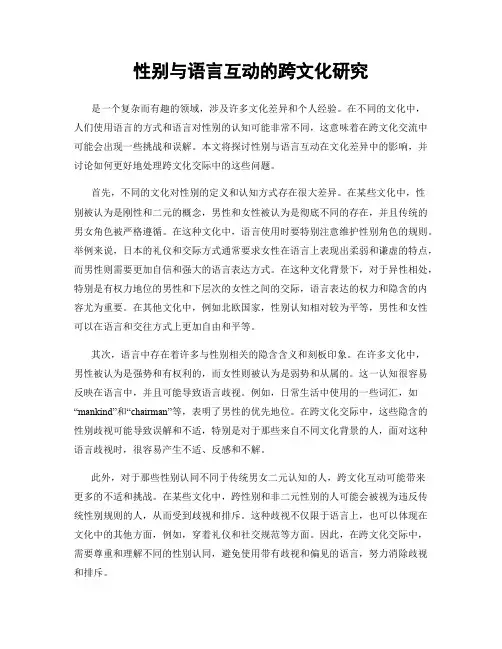
性别与语言互动的跨文化研究是一个复杂而有趣的领域,涉及许多文化差异和个人经验。
在不同的文化中,人们使用语言的方式和语言对性别的认知可能非常不同,这意味着在跨文化交流中可能会出现一些挑战和误解。
本文将探讨性别与语言互动在文化差异中的影响,并讨论如何更好地处理跨文化交际中的这些问题。
首先,不同的文化对性别的定义和认知方式存在很大差异。
在某些文化中,性别被认为是刚性和二元的概念,男性和女性被认为是彻底不同的存在,并且传统的男女角色被严格遵循。
在这种文化中,语言使用时要特别注意维护性别角色的规则。
举例来说,日本的礼仪和交际方式通常要求女性在语言上表现出柔弱和谦虚的特点,而男性则需要更加自信和强大的语言表达方式。
在这种文化背景下,对于异性相处,特别是有权力地位的男性和下层次的女性之间的交际,语言表达的权力和隐含的内容尤为重要。
在其他文化中,例如北欧国家,性别认知相对较为平等,男性和女性可以在语言和交往方式上更加自由和平等。
其次,语言中存在着许多与性别相关的隐含含义和刻板印象。
在许多文化中,男性被认为是强势和有权利的,而女性则被认为是弱势和从属的。
这一认知很容易反映在语言中,并且可能导致语言歧视。
例如,日常生活中使用的一些词汇,如“mankind”和“chairman”等,表明了男性的优先地位。
在跨文化交际中,这些隐含的性别歧视可能导致误解和不适,特别是对于那些来自不同文化背景的人,面对这种语言歧视时,很容易产生不适、反感和不解。
此外,对于那些性别认同不同于传统男女二元认知的人,跨文化互动可能带来更多的不适和挑战。
在某些文化中,跨性别和非二元性别的人可能会被视为违反传统性别规则的人,从而受到歧视和排斥。
这种歧视不仅限于语言上,也可以体现在文化中的其他方面,例如,穿着礼仪和社交规范等方面。
因此,在跨文化交际中,需要尊重和理解不同的性别认同,避免使用带有歧视和偏见的语言,努力消除歧视和排斥。
为了更好地处理跨文化互动中的性别和语言问题,我们需要采取一些措施。



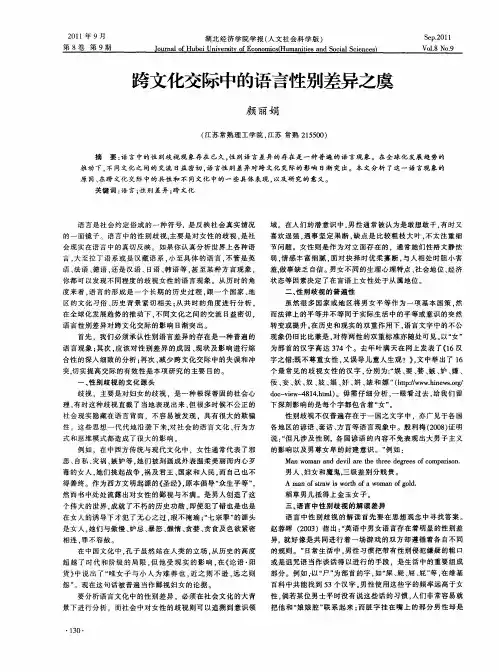
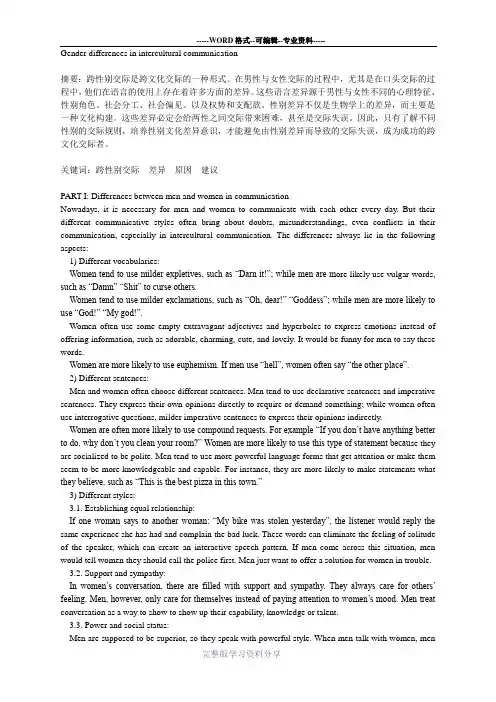
Gender differences in intercultural communication摘要:跨性别交际是跨文化交际的一种形式。
在男性与女性交际的过程中,尤其是在口头交际的过程中,他们在语言的使用上存在着许多方面的差异。
这些语言差异源于男性与女性不同的心理特征、性别角色、社会分工、社会偏见、以及权势和支配欲。
性别差异不仅是生物学上的差异,而主要是一种文化构建。
这些差异必定会给两性之间交际带来困难,甚至是交际失误。
因此,只有了解不同性别的交际规则,培养性别文化差异意识,才能避免由性别差异而导致的交际失误,成为成功的跨文化交际者。
关键词:跨性别交际差异原因建议PART I: Differences between men and women in communicationNowadays, it is necessary for men and women to communicate with each other every day. But their different communicative styles often bring about doubts, misunderstandings, even conflicts in their communication, especially in intercultural communication. The differences always lie in the following aspects:1) Different vocabularies:Women tend to use milder expletives, such as “Darn it!”; while men are m ore likely use vulgar words, such as “Damn” “Shit” to curse others.Women tend to use milder exclamations, such as “Oh, dear!” “Goddess”; while men are more likely to use “God!” “My god!”.Women often use some empty extravagant adjectives and hyperboles to express emotions instead of offering information, such as adorable, charming, cute, and lovely. It would be funny for men to say these words.Women are more likely to use euphemism. If men use “hell”, women often say “the other place”.2) Different sentences:Men and women often choose different sentences. Men tend to use declarative sentences and imperative sentences. They express their own opinions directly to require or demand something; while women often use interrogative questions, milder imperative sentences to express their opinions indirectly.Women are often more likely to use compound requests. For example “If you don’t have anything better to do, why don’t you clean your room?” Women are more likely to use this type of statement becau se they are socialized to be polite. Men tend to use more powerful language forms that get attention or make them seem to be more knowledgeable and capable. For instance, they are more likely to make statements what they believe, such as “This is the best pizza in this town.”3) Different styles:3.1. Establishing equal relationship:If one woman says to another woman: “My bike was stolen yesterday”, the listener would reply the same experience she has had and complain the bad luck. These words can eliminate the feeling of solitude of the speaker, which can create an interactive speech pattern. If men come across this situation, men would tell women they should call the police first. Men just want to offer a solution for women in trouble.3.2. Support and sympathy:In women’s conversation, there are filled with support and sympathy. They always care for others’ feeling. Men, however, only care for themselves instead of paying attention to women’s mood. Men treat conversation as a way to show to show up their capability, knowledge or talent.3.3. Power and social status:Men are supposed to be superior, so they speak with powerful style. When men talk with women, menoften control the turn of the topics and the sequence of the speakers. Men often interrupt the conversation or get the speech floor; men pay no attention to women by reacting with their minimal responses such as “mhm”.Compared with men, women are inferior and controlled by men. They speak with powerless style. When they talk with men, women are passive and modest by using interrogative sentences, tag sentences and so on. Women often treat these as a way to develop the conversation or draw attention of men.3.4. Continuation of conversation:By raising questions, women hope that others can continue the conversation. Whenever they finish a topic, they can turn to another smoothly. The principle of cooperation is well represented by women.Men often show they are busy by speaking a few words and then leaving hurriedly.3.5. Tone:W omen are more frequent to use super high and low tone. The tone can fully express the speakers’ emotion and is one of the characteristics of women. Women would like to answer questions with rising tone to show their uncertainty. Women are more frequent to use falling-raising tone and raising-falling-raising tone. The falling-raising tone shows hesitate-apologetic meaning and the raising-falling-raising tone an enthusiastic situation.4) Different strategies:4.1. Direct and indirect:Men tend to be direct w hen they express themselves, while women are often indirect. However, it isn’t always like this. In some cases, it is the women who are expecting direct statements and the men who are expressing themselves indirectly. The issue is not directness or indirectness; the issue is the current interpretive framework.4.2. Fit to specific environment:According to observation, in different conversation environment, women and men tend to speak differently. For example, in a business meeting, the most of the talk would be dominated by men. However, men tend to be sullen and silent when they are at home.4.3. Intimacy and independence:Here is an example. Josh, the husband, gets a call from an old friend who will be visiting the town that Josh lives in, and he immediately invites him to stay at their house. Later, when he tells Linda, the wife, she is upset because he didn’t discuss it with her before making the invitation. He tells her that he doesn’t want to be seen as asking his wife for permission in front of his old friend. From this example, we can see that what is of concern to the man is his independence while for the woman it is their intimacy. In other words, he is concerned for his status as being free to make up his own mind whereas she is concerned for their connection.4.4. Rapport and information:Men are more likely to use what gender communication expert Deborah Tannen calls “report-making language” that centers on facts, information, and getting the job done. Women are more likely to use “rapport-buildi ng language” which considers message content and the relationship between the people communicating.5) Different topics:Women prefer to talk about daily life, such as family, children, health, fashion and love; while men are interested in big and serious topics, such as politics, money, sports and sex.6) Different focus:Women are emotional and sometimes, exaggerate with metaphors. Men concern only the word, just interpret the literal meaning. Women just want to express a kind of feeling. Men may take it seriously because they can’t know the implication of women. That’s why men may misunderstand women.There are still many other differences between men and women. I would not say more here.PART II: Reasons for these differencesWhy are there so many differences? The factors that affect the differences are:1) Social factors:Men and women have different languages because they treat language as a social symbol. They choose the languages according to the social pressure, atmosphere and others. The language they choose is fit for their status. Even though men and women live in the same society, women tend to use formal language. Men are endowed with power and women cannot have the same stable social status as men, in most cases, women are inferior to men. Women need to show and protect their identity or social status. So, women obtain kind of potential prestige during the process of obtaining collective identification by using standard language form.2) Cultural factors:Men and women belong to different sub-cultural groups. The research shows that the different groups are formed when men and women are young, and they have different acting ways. These differences make them realize the gender identity.Language is affected by social-cultural factors. Women tend to use standardized language because standardized language is thought to be the language used by upper class with high reputation. The motivation of using the hypercorrect standardized language is thought to enter the upper class. This is obvious for women. Women have fewer rights for materials than men. Women tend to speak standardized language for two reasons: a> Women have the obligation of raising the offspring and spreading culture to them, so they know how important it is for the offspring to learn standardized language. b> Traditionally, women’s social status is not so stable as that of men, so it is necessary for women to mark and stabilize their social status. So they realize how important standardize language.3) Political reason:Lakoff explained the gender differences were caused by social inequality. Besides, as long as the power imbalance existed, women were in difficulty and confined doubly because the languages and behaviors were thought of defective. On the other hand, if women were near to or copy the speaking way of men, these women were discarded for they weren’t women.For example, one female accountant in one American accounting office is capable and makes great contributions to the office and is popular with her c lients, but can’t be promoted because her manner and behaviors are like those of men. This is not relevant to her work, but she is recommended speaking, walking and dressing up like a woman.4) Psychological reason:Boe explains the differences between men and women from the social-psychological point. She believes that women’s choice of language is closely related to their psychological development. This emphasizes that women would consider others first. This psychological tendency is a kind of socialized ability, that is, the ability to keep and maintain the friendly relationship with others. Cooperation is the premise of considering others. This psychological tendency is reflected on the use of language.PART III: Suggestions for successful intercultural communicationNow that we have already known the differences and the reasons of these differences, we should try to avoid the miscommunication between men and women. What we should do are:1) Accepting gender culture differences:To be aware of the existence of discrepancy between cultures is the first step to walk into the door of successful intercultural communication. We must observe and study the differences so that we can avoidmiscommunication skillfully. It is difficult for most people to tolerate the differences of other cultures in some specific aspects such as beliefs, values and attitudes. People often view others from their own perspectives, since judgment can not be made without individual’s experience. Therefore, it is important for us to suspend judgment. We should accept the existence of gender culture differences and try to explore constructively what happens and how our partner acts so that we might better understand each other. We need to view objectively aspects of other culture that differs from that of our own.2) Learning to be tolerant:The two gender cultures are different in many ways. We should be tolerant to these cultural differences. Keep in mind that we are both alike and different. We should grant similarities and recognize differences. By learning that men and women are different, we can become more sensitive to the fact that men and women’s values and goals may differ, and generally their verbal and nonverbal language will vary as well. Instead of becoming annoyed by a ma le’s aggressive communication style, we should recognize that it is a style which is as much a part of his identity as an ethnic cuisine or a religious tradition is part of culture. By accepting and appreciating both, we can better assess the potential consequences of our acts and be more tolerant of those others.3) Learning to respect:The task in improving intercultural communication is awareness and respect than evaluation. Plato says, “No law or ordinance is more than understanding”. A successful commu nicator should be aware of others, care for others, respect others, and should not be pre-occupied with thoughts over them.4) Learning to be open and flexible:Studying other culture’s communication teaches us not only about other cultures, but also about ourselves. If we are open to learn and grow, we can enlarge our own communication repertoire by incorporating more emphasized in other cultures.Openness implies a willingness to accept cultural differences and is not closed to new ideas. Flexibility implies a willingness to use various ways to communicate. We need to be flexible and adapt our communication style to each culture and situation that confronts us.CONCLUSION:This thesis has mainly discussed some aspects of gender differences and speech. After that, the reasons for the gender differences are explored. At last, this thesis put forward some suggestion on how to improve intercultural communication.REFERENCES:Coates, J. and D. Cameron(1988) Women in Their Speech Communities: New Perspectives on Language and Sex. London and New York: LongmanEckert, Penelope(1996) The Whole Woman: Sex and Gender Differences in Variation. In Brenneis许力生.《跨文化交流入门》[M] 浙江大学出版社,2004吴晓. 跨文化交际中的性别差异和话语风格[J] 东北财经大学,2006张维友. 《高级综合英语教程》[M] 高等教育出版社,2001颜丽娟. 跨文化交际中的语言性别差异之虞[J] 湖北经济学院,2011张聪. 英汉跨文化交际中的性别差异[J] 长春理工大学,2009。

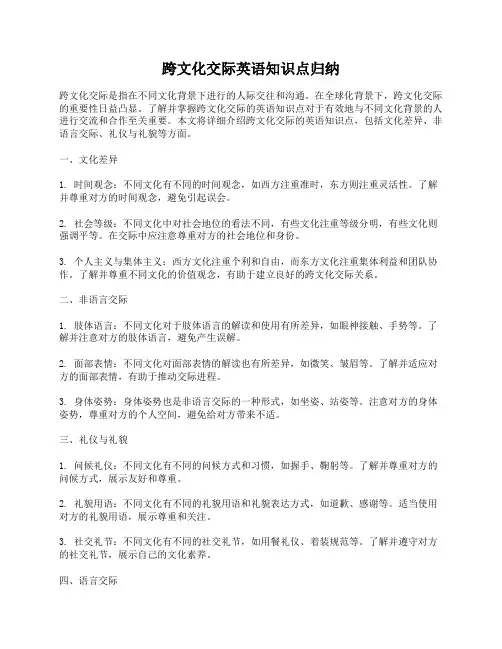
跨文化交际英语知识点归纳跨文化交际是指在不同文化背景下进行的人际交往和沟通。
在全球化背景下,跨文化交际的重要性日益凸显。
了解并掌握跨文化交际的英语知识点对于有效地与不同文化背景的人进行交流和合作至关重要。
本文将详细介绍跨文化交际的英语知识点,包括文化差异、非语言交际、礼仪与礼貌等方面。
一、文化差异1. 时间观念:不同文化有不同的时间观念,如西方注重准时,东方则注重灵活性。
了解并尊重对方的时间观念,避免引起误会。
2. 社会等级:不同文化中对社会地位的看法不同,有些文化注重等级分明,有些文化则强调平等。
在交际中应注意尊重对方的社会地位和身份。
3. 个人主义与集体主义:西方文化注重个利和自由,而东方文化注重集体利益和团队协作。
了解并尊重不同文化的价值观念,有助于建立良好的跨文化交际关系。
二、非语言交际1. 肢体语言:不同文化对于肢体语言的解读和使用有所差异,如眼神接触、手势等。
了解并注意对方的肢体语言,避免产生误解。
2. 面部表情:不同文化对面部表情的解读也有所差异,如微笑、皱眉等。
了解并适应对方的面部表情,有助于推动交际进程。
3. 身体姿势:身体姿势也是非语言交际的一种形式,如坐姿、站姿等。
注意对方的身体姿势,尊重对方的个人空间,避免给对方带来不适。
三、礼仪与礼貌1. 问候礼仪:不同文化有不同的问候方式和习惯,如握手、鞠躬等。
了解并尊重对方的问候方式,展示友好和尊重。
2. 礼貌用语:不同文化有不同的礼貌用语和礼貌表达方式,如道歉、感谢等。
适当使用对方的礼貌用语,展示尊重和关注。
3. 社交礼节:不同文化有不同的社交礼节,如用餐礼仪、着装规范等。
了解并遵守对方的社交礼节,展示自己的文化素养。
四、语言交际1. 语言障碍:不同文化使用不同的语言,语言障碍是跨文化交际中常见的问题。
尽量使用简洁明了的词汇和表达方式,避免产生歧义和误解。
2. 文化障碍:语言与文化密切相关,不同文化对于词汇、语法和表达方式有不同的理解和运用。


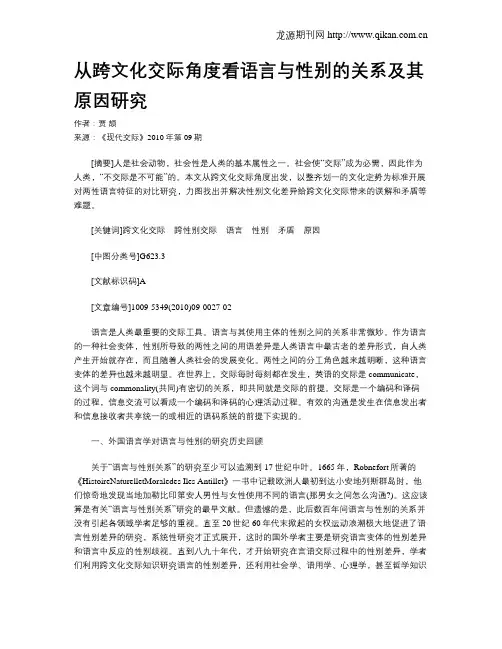
从跨文化交际角度看语言与性别的关系及其原因研究作者:贾颉来源:《现代交际》2010年第09期[摘要]人是社会动物,社会性是人类的基本属性之一。
社会使“交际”成为必需,因此作为人类,“不交际是不可能”的。
本文从跨文化交际角度出发,以整齐划一的文化定势为标准开展对两性语言特征的对比研究,力图找出并解决性别文化差异给跨文化交际带来的误解和矛盾等难题。
[关键词]跨文化交际跨性别交际语言性别矛盾原因[中图分类号]G623.3[文献标识码]A[文章编号]1009-5349(2010)09-0027-02语言是人类最重要的交际工具。
语言与其使用主体的性别之间的关系非常微妙。
作为语言的一种社会变体,性别所导致的两性之间的用语差异是人类语言中最古老的差异形式,自人类产生开始就存在,而且随着人类社会的发展变化。
两性之间的分工角色越来越明晰,这种语言变体的差异也越来越明显。
在世界上,交际每时每刻都在发生,英语的交际是communicate,这个词与commonality(共同)有密切的关系,即共同就是交际的前提。
交际是一个编码和译码的过程,信息交流可以看成一个编码和译码的心理活动过程。
有效的沟通是发生在信息发出者和信息接收者共享统一的或相近的语码系统的前提下实现的。
一、外国语言学对语言与性别的研究历史回顾关于“语言与性别关系”的研究至少可以追溯到17世纪中叶。
1665年,Robnefort所著的《HistoireNaturelletMoraledes Iles Antillet》一书中记载欧洲人最初到达小安地列斯群岛时,他们惊奇地发现当地加勒比印第安人男性与女性使用不同的语言(那男女之间怎么沟通?)。
这应该算是有关“语言与性别关系”研究的最早文献。
但遗憾的是,此后数百年间语言与性别的关系并没有引起各领域学者足够的重视。
直至20世纪60年代末掀起的女权运动浪潮极大地促进了语言性别差异的研究,系统性研究才正式展开,这时的国外学者主要是研究语言变体的性别差异和语言中反应的性别歧视。